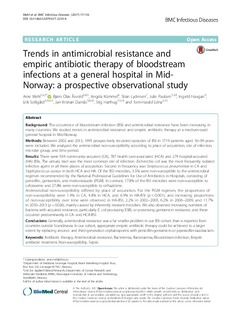| dc.contributor.author | Mehl, Arne | |
| dc.contributor.author | Åsvold, Bjørn Olav | |
| dc.contributor.author | Kümmel, Angela | |
| dc.contributor.author | Lydersen, Stian | |
| dc.contributor.author | Paulsen, Julie | |
| dc.contributor.author | Haugan, Ingvild | |
| dc.contributor.author | Solligård, Erik | |
| dc.contributor.author | Damås, Jan Kristian | |
| dc.contributor.author | Harthug, Stig | |
| dc.contributor.author | Edna, Tom-Harald | |
| dc.date.accessioned | 2017-08-31T07:22:53Z | |
| dc.date.available | 2017-08-31T07:22:53Z | |
| dc.date.created | 2017-05-28T12:02:10Z | |
| dc.date.issued | 2017 | |
| dc.identifier.citation | BMC Infectious Diseases. 2017, 17:116 1-11. | nb_NO |
| dc.identifier.issn | 1471-2334 | |
| dc.identifier.uri | http://hdl.handle.net/11250/2452479 | |
| dc.description.abstract | Background
The occurrence of bloodstream infection (BSI) and antimicrobial resistance have been increasing in many countries. We studied trends in antimicrobial resistance and empiric antibiotic therapy at a medium-sized general hospital in Mid-Norway.
Methods
Between 2002 and 2013, 1995 prospectively recorded episodes of BSI in 1719 patients aged 16–99 years were included. We analyzed the antimicrobial non-susceptibility according to place of acquisition, site of infection, microbe group, and time period.
Results
There were 934 community-acquired (CA), 787 health care-associated (HCA) and 274 hospital-acquired (HA) BSIs. The urinary tract was the most common site of infection. Escherichia coli was the most frequently isolated infective agent in all three places of acquisition. Second in frequency was Streptococcus pneumoniae in CA and Staphylococcus aureus in both HCA and HA. Of the BSI microbes, 3.5% were non-susceptible to the antimicrobial regimen recommended by the National Professional Guidelines for Use of Antibiotics in Hospitals, consisting of penicillin, gentamicin, and metronidazole (PGM). In contrast, 17.8% of the BSI microbes were non-susceptible to cefotaxime and 27.8% were non-susceptible to ceftazidime.
Antimicrobial non-susceptibility differed by place of acquisition. For the PGM regimen, the proportions of non-susceptibility were 1.4% in CA, 4.8% in HCA, and 6.9% in HA-BSI (p < 0.001), and increasing proportions of non-susceptibility over time were observed in HA-BSI, 2.2% in 2002–2005, 6.2% in 2006–2009, and 11.7% in 2010–2013 (p = 0.026), mainly caused by inherently resistant microbes. We also observed increasing numbers of bacteria with acquired resistance, particularly E. coli producing ESBL or possessing gentamicin resistance, and these occurred predominantly in CA- and HCA-BSI.
Conclusions
Generally, antimicrobial resistance was a far smaller problem in our BSI cohort than is reported from countries outside Scandinavia. In our cohort, appropriate empiric antibiotic therapy could be achieved to a larger extent by replacing second- and third-generation cephalosporins with penicillin-gentamicin or piperacillin-tazobactam. | nb_NO |
| dc.language.iso | eng | nb_NO |
| dc.publisher | BioMed Central | nb_NO |
| dc.rights | Navngivelse 4.0 Internasjonal | * |
| dc.rights.uri | http://creativecommons.org/licenses/by/4.0/deed.no | * |
| dc.title | Trends in antimicrobial resistance and empiric antibiotic therapy of bloodstream infections at a general hospital in Mid-Norway: A prospective observational study | nb_NO |
| dc.type | Journal article | nb_NO |
| dc.type | Peer reviewed | nb_NO |
| dc.description.version | publishedVersion | nb_NO |
| dc.source.pagenumber | 1-11 | nb_NO |
| dc.source.volume | 17:116 | nb_NO |
| dc.source.journal | BMC Infectious Diseases | nb_NO |
| dc.identifier.doi | 10.1186/s12879-017-2210-6 | |
| dc.identifier.cristin | 1472321 | |
| dc.description.localcode | © The Author(s) 2017. This article is distributed under the terms of the Creative Commons Attribution 4.0 International License (http://creativecommons.org/licenses/by/4.0/), which permits unrestricted use, distribution, and reproduction in any medium, provided you give appropriate credit to the original author(s) and the source, provide a link to the Creative Commons license, and indicate if changes were made. | nb_NO |
| cristin.unitcode | 194,65,15,0 | |
| cristin.unitcode | 194,65,20,15 | |
| cristin.unitcode | 194,65,35,0 | |
| cristin.unitcode | 194,65,25,0 | |
| cristin.unitname | Institutt for kreftforskning og molekylær medisin | |
| cristin.unitname | Helseundersøkelsen i Nord-Trøndelag | |
| cristin.unitname | Regionalt kunnskapssenter for barn og unge - Psykisk helse og barnevern | |
| cristin.unitname | Institutt for sirkulasjon og bildediagnostikk | |
| cristin.ispublished | true | |
| cristin.fulltext | original | |
| cristin.qualitycode | 1 | |

